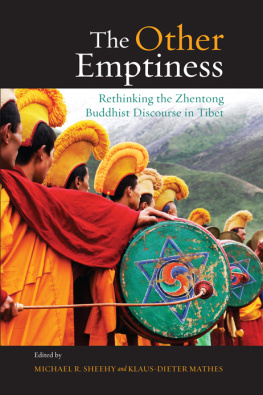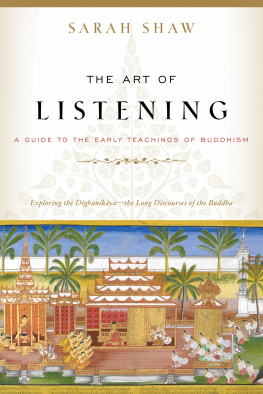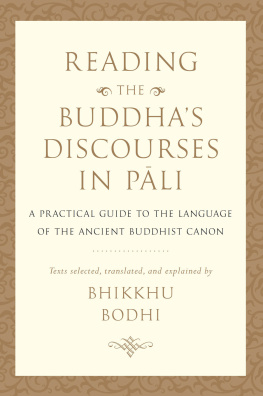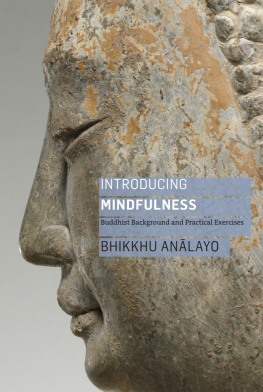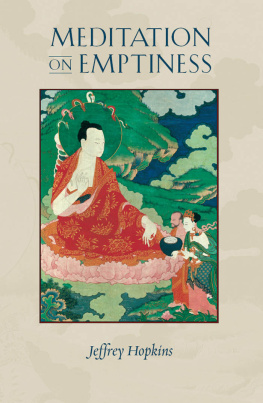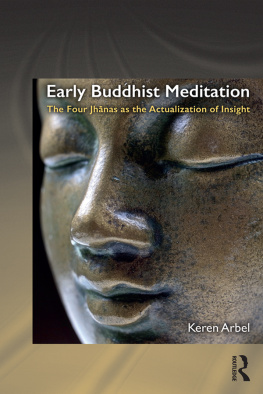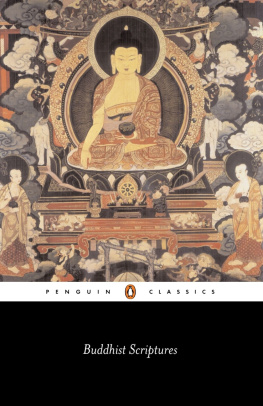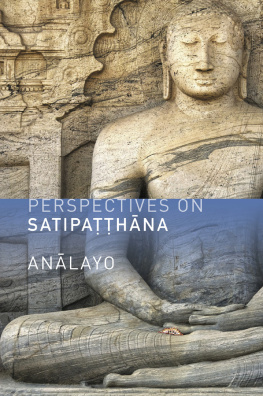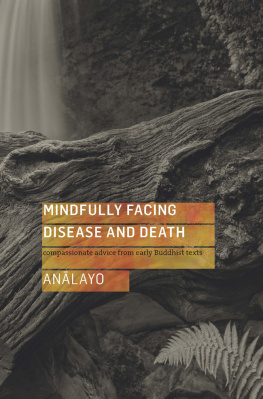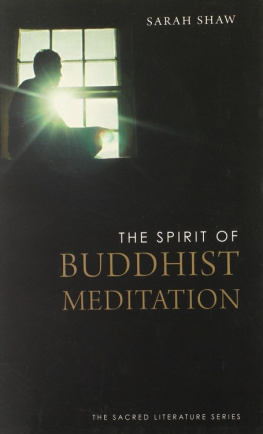This book is the result of rigorous textual scholarship that can be valued not only by the academic community, but also by Buddhist practitioners. This book serves as an important bridge between those who wish to learn about Buddhist thought and practice and those who wish to learn from it.... As a monk engaging himself in Buddhist meditation as well as a professor applying a historical-critical methodology, Bhikkhu Anlayo is well positioned to bridge these two communities who both seek to deepen their understanding of these texts. from the Foreword, 17th Karmapa Ogyen Trinley Dorje
In this study, Venerable Anlayo Bhikkhu brings a meticulous textual analysis of Pali texts, the Chinese Agamas and related material from Sanskrit and Tibetan to the foundational topics of compassion and emptiness. While his analysis is grounded in a scholarly approach, he has written this study as a helpful guide for meditation practice. The topics of compassion and emptiness are often associated with Tibetan Buddhism but here Venerable Anlayo makes clear their importance in the early Pali texts and the original schools. Jetsunma Tenzin Palmo
This is an intriguing and delightful book that presents these topics from the viewpoint of the early suttas as well as from other perspectives, and grounds them in both theory and meditative practice. Bhikshuni Thubten Chodron
A gift of visionary scholarship and practice. Anlayo holds a lamp to illuminate how the earliest teachings wed the great heart of compassion and the liberating heart of emptiness and invites us to join in this profound training. Jack Kornfield
Arising from the authors long-term, dedicated practice and study, Compassion and Emptiness in Early Buddhist Meditation provides a window into the depth and beauty of the Buddhas liberating teachings. Serious meditation students will benefit tremendously from the clarity of understanding that Venerable Anlayos efforts have achieved. Sharon Salzberg
I was taught by some Mahyna Buddhist teachers that non-Mahyna forms of Buddhism, including pre-Mahyna schools of Buddhism, lack deep teachings on compassion and emptiness, which made them inferior to Mahyna Buddhisms. After I began to study the Pali texts on my own, such claims no longer seemed cogent to me. They seem to be part of an unfortunate Buddhist sectarianism that is still prevalent. This scholarly book is more than timely with its demonstrations that teachings on emptiness and compassion that are helpful to practitioners of any form of Buddhism are abundant in early Buddhist texts. Professor Rita M. Gross
Also by Anlayo
Satipahna: The Direct Path to Realization
The Genesis of the Bodhisattva Ideal
A Comparative Study of the Majjhima-nikya
Excursions into the Thought-world of the Pli Discourses
Perspectives on Satipahna
The Dawn of Abhidharma
C OMPASSION AND E MPTINESS IN E ARLY BUDDHIST M EDITATION
Anlayo

Windhorse Publications
169 Mill Road
Cambridge
CB1 3AN
UK
www.windhorsepublications.com
Anlayo, 2015
Electronic edition 2015
The right of Anlayo to be identified as the author of this work has been asserted by him in accordance with the Copyright, Designs and Patents Act 1988.
As an act of Dhammadna, Anlayo has waived royalty payments for this book.
Cover design by Dhammarati
Typesetting and layout by Ruth Rudd
British Library Cataloguing in Publication Data:
A catalogue record for this book is available from the British Library.
Paperback ISBN: 978 1 909314 55 9
ebook ISBN: 978 1 909314 62 7
Windhorse Publications would be pleased to hear about your reading
experiences with this Ebook at:
References to Internet web sites (URLs) were accurate at the time of writing. Neither the author nor Windhorse Publications is responsible for URLs that may have expired or changed since the manuscript was prepared.
CONTENTS
ABOUT THE AUTHOR
Born in 1962 in Germany, Bhikkhu Anlayo was ordained in 1995 in Sri Lanka, and completed a PhD on the Satipahna-sutta at the University of Peradeniya, Sri Lanka, in 2000 published in 2003 by Windhorse Publications under the title Satipahna: The Direct Path to Realization.
Anlayo is a professor at the Numata Center for Buddhist Studies of the University of Hamburg and researches at the Dharma Drum Institute of Liberal Arts in Taiwan. His main research area is early Buddhism and in particular the topics of the Chinese gamas, meditation, and women in Buddhism. Besides his academic pursuits, he spends about half of his time in meditation under retreat conditions and regularly teaches meditation courses in Asia and the West.
ACKNOWLEDGEMENTS AND DEDICATION
I am indebted to Shaila Catherine, Adam Clarke, Smaer Dhammadinn, Dawn P. Neal, Mike Running, Jill Shepherd, and Shi Syinchen for having helped me to improve my presentation. Any shortcomings in the following pages are entirely due to my own ignorance.
I would like to dedicate this book to the memory of Godwin Samararatne (19322000), a Sri Lankan meditation teacher believed by many to have reached an advanced level in his cultivation of the bodhisattva path, for having in a very practical way taught me compassion and emptiness in their inseparability.
PUBLISHERS ACKNOWLEDGEMENTS
Windhorse Publications wishes to gratefully acknowledge and thank the individual donors who gave to the books production via our Sponsor-a-book campaign in 2014 and 2015.

FOREWORD BY H.H. THE 17TH KARMAPA
I am pleased to have the opportunity to introduce this book by Professor Dr Bhikkhu Anlayo, not only as a contribution to our understanding of early Buddhist meditation, but as a work of bridge-building on many levels.
First of all, Compassion and Emptiness in Early Buddhist Meditation is the result of rigorous textual scholarship that can be valued not only by the academic community but also by Buddhist practitioners. This book serves as an important bridge between those who wish to learn about Buddhist thought and practice and those who wish to learn from it. I believe this bridge-building is valuable, as academic scholarship on Buddhist texts is greatly enriched by taking into consideration the uses to which such texts are put in the lives of practitioners. As a monk engaging himself in Buddhist meditation as well as a professor applying a historical-critical methodology, Bhikkhu Anlayo is well positioned to bridge these two communities who both seek to deepen their understanding of these texts.
Secondly, I also believe that those studying Buddhism within one tradition are well advised to consider the texts preserved in other traditions canons. Too often, we allow language to become a barrier and overlook the versions of our own texts extant in other languages. The bridge built in this book between Pli, Sanskrit, Chinese, and Tibetan texts reveals just how widely shared the concern with cultivating compassion and understanding emptiness is. It also allows us to reflect on the nuances of the differences in their presentation in varying contexts.
Finally, this book brings together the two topics of compassion and emptiness within a single work, and highlights the value of treating them as mutually complementary. In this way, as we might say in Mahyna Buddhism, Bhikkhu Anlayo has ensured that the two wings of the bird remain united, allowing meditative experience and philosophical understanding to truly take flight.
Next page

